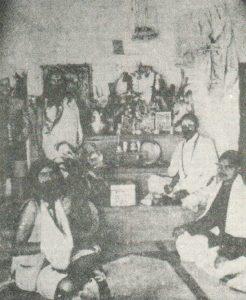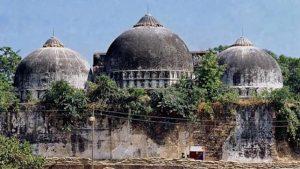Ayodhya Dispute: We Don’t Want the Mosque If Not on Its Own Site
By Syyed Mansoor Agha
How would one explain the Divine wisdom and scheme in the fact that the mosque built by Shah Jahan in Delhi became so popular that not only the faithful but even non-Muslims from all over the world get attracted to it and visit it in large numbers. Of the daily five-times-prayers not a single congregation is held here when thousands do not bow their heads in submission to the Supreme Lord. During Ramazan dozens of Huffaz [those who have memorised Qur’an by heart], recite Qur’an in separate congregations. After 1857, the British forces occupied it and kept their horses in it as their stable. However, those bad times passed away and the call for prayers started to echo once again from its minarets. Today it enjoys the status of being the central mosque. All praise is due to Allah alone that, anyone whosoever gets associated with it also gets respectability.
On the contrary Babar’s commander-in-chief Meer Baqi also built a mosque in Ayodhya, that from architectural point of view was also a unique monument. And that became famous as well but altogether due to the wrong reasons.
We are not in a position to pass any judgement about piety of the emperor Shah Jahan or express any doubts about the wisdom and sincerity of Meer Baqi. However, one does feel curious to find such a contrast in their separate destinies?
When the Prophet (PBUH) migrated to Makkah and decided to build a mosque and selected a site for the mosque, first of all he enquired about the owner of that piece of land. The owners who were all minors, and their guardians offered to gift the land but the Prophet (PBUH) was so careful in his dealings that he refused to accept it as a gift. Instead, he bought it by paying a higher price than its market value and then got the a mosque built there.
Therefore, we have ground to assume that in selecting the mount ‘Ramkot’ for the construction of the mosque Meer Baqi was a bit careless. He did not pay attention to the caution the example of which had been set by the Prophet (PBUH).
It can be assumed that [in taking such a decision] the Governor of Avadh was carried away by the power of temporary political supremacy he had enjoyed then otherwise a controversy would not have ensued shortly.
Babar established his reign in India in 1526. The mosque was built between 1528-29. Babar’s grandson succeeded the throne in 1556 and the controversy of the mosque was brought for hearing in his court as well. The king found a compromising middle way and got a 17x21ft platform constructed inside the enclosure of the mosque adjacent to the main gate where idols of Rama, Sita, and Lakshman were installed and their worship continued for a long time. (Probably this is the reason why this mosque was also called ‘Masjid-e-Janam-Sthan’ (Babri Masjid by Late Syed Sabahuddin Abrur-Rehman). These were the idols that were placed in the main niche [Mehrab] of the mosque in 1949.

Until 1949, the matter remained a local controversy. But soon after the partition its status changed and it was converted into an issue of belief v/s faith.
According to Hindu beliefs Rama is the incarnation of Vishnu and appeared on the earth during ‘Trita Yuga’ that spanned over 1,296,000 years of lunar calendar. This was followed by ‘Dvapara Yuga’ that lasted 864,000 years. The present is the Kalyug that would end after 4,32,000 years. This means that Rama was born around 21 lakh years ago.
Although the time of the compilation of vedas is estimated to be one crore and 97 lakh years, the tekas [verses] in them have continued to be written in all the ages and have gotten merged in them in such a manner that it is impossible to differentiate them separately. Same is true of Upanishads. However, none of the Hindu scriptures testifies that Rama was born at the site where Babri Mosque had stood. But this is a useless debate. What we know is that there is no way to pin point a place where any of the prominent personalities of our time was born in an area of at 4 sq ft, like the claim being made that Ramachandra was born exactly where the Mehrab of the mosque was. He was born in pre-historic times though. In this regard Gandhiji had gone as far as saying that Ramachandraji did not even exist in history. But then, faith is a personal matter that has for manifest reasons now been turned into a political gimmick.
The political process of promoting and propagating this belief was started soon after independence when on 22 and 23 December 1949 and idols were removed from the platform and put inside the Mehrab of the mosque. It reached to its climax when, on 6 December 1992, on the call of L. K Advani, Ashok Singhal and other Sanghi leaders hundreds of thousands of lawbreakers assembled in Ayodhya and in the presence of these very leaders, pulled down an ancient place of worship. Then on the rubbles a makeshift temple was erected under the patronage of the government.
It hardly needs to be told who played what kind of role in all this. When the idols were installed in the mosque it was Congress’s government, both at the Centre and in the state. When Shilanias [foundation laying ceremony of the temple] was performed it was again Congress’s rule and when the mosque was demolished it was the Congress that was in power. This is also as clear as the day that Sangh Parivar’s mischievous trick to turn it into a national issue was a tit for tat response to Congress’s [dirty] politics.
Although Liberhan Commission has talked about Gulzarilal Nanda’s role in promoting poisonous Hindu nationalism, but it has spared the others. The names of many of them are still afresh in mind. For example the symbol of modernity Prime Minister Rajiv Gandhi (hailed by Subrmanian Swami as ‘the only Hindu neta’), his Home Minister Sardar Buta Singh and State Minister for Home Affairs Arun Nehru, on whose persuasion Babri Mosque was unlocked and then just few days before the election ShilaNias was performed with great pomp and show. Rajiv Gandhi started his election campaign from Ayodhya with a promise to establish ‘Ram Rajiya’.
Although Rajiv Gandhi was born in a political family, he was not interested in politics. He was dragged into politics after the death in 1989 of his younger brother Sanjay Gandhi in an aeroplane accident and only four years later, following the death in 1984 of Mrs Indira Gandhi he was made the Prime Minister of the country. Such accidents are not the alternate of political experience. He remained dependent on his advisors.
Before the unlocking of the Babri Mosque for whole year a serial on Ramayan was telecast on Doordarshan as a result of which the images of the greatness of Rama were carved on the minds of the people. The following series of events like the unlocking of the mosque, organising Shilanyas and reminding the forgotten lesson of ‘Ram Rajya’ etc. was a political move and negation of the policies of enlightenment and development for which his short-sighted and devoid-of-the-demands-of-secularism advisors were not less guilty. These were not coincidents but an organised campaign to inflame religious feelings of Hindus and gain electoral benefits. Thereafter the movement of Hindu majoritisation took a new flight and the storm created by it swept away the Congress itself. The environment created by the Congress was stolen by Advani and BJP.
The controversy over the ownership of Babri Mosque site is not new. A Hindu priest Raghuveer Das had filed in January 1885 a petition with the judge of Faizabad alleging that the site where Babri Mosque stood was in fact Ramjanam Bhoomi and that permission be given to construct a Rama Temple there. But the Judge, Pundit Harikishan, rejected the petition. After the installation of idols inside the Mosque in 1949 cases were filed by both parties. It is the appeal of these two cases in the Supreme Court that have been going on for the last 69 years. On 21 March a new controversy got started when Chief Justice J.S. Khehar advised both the parties to settle the matter through mediation and said that he was himself ready to arbitrate in it. ‘These are issues of religion and sentiments. These are issues where all the parties can sit together and arrive at a consensual decision to end the dispute. All of you may sit together and hold a cordial meeting,’ he said, ‘If you want me between mediators of both sides, I am ready.’ This suggestion has ignited a new controversy.
As a matter of principle, the court must decide the ownership of the land and the government must enforce this judgement. But there are precedents that in sensitive cases court’s judgements have failed to be enforced.
The situation demands a farsighted political strategy than simply sticking to principles. Our approach should be aimed at winning the support and sympathies of impartial, fair and justice-loving Indians and the goodwill of the Supreme Court. Rejecting Chief Justice’s offer in a press conference is an extremely inappropriate and unwise move.
In this particular case one thing is as clear as the day: if the judgement comes against Muslims they would quietly go home. But if it goes against the Hindus this may ignite a wave of violence that would be far more destructive and murderous than the 1992 post-Babri Mosque demolition riots and Gujarat 2002 massacre. Our response should be decided keeping in view this possibility. The situation demands a farsighted political strategy than simply sticking to principles. Our approach should be aimed at winning the support and sympathies of impartial, fair and justice-loving Indians and the goodwill of the Supreme Court. Rejecting Chief Justice’s offer in a press conference is an extremely inappropriate and unwise move.
A similar proposal had formally come in June 2003 from the Kanchi Shankaracharya in which it was proposed that if the Ayodhya land was donated [to the Hindus], in its response thousands of mosques locked by Archaeological Survey of India would be unlocked for prayers. Nine percent reservation would be given to Muslim youths in government jobs. Claim [by Hindus] on the mosques of Mathura and Kashi would be withdrawn. At that time there was a reason to believe that this proposal had the backing of Vajpayee Government.
A two page copy of these proposals was sent to All India Muslim Personal Law Board (AIMPL). But these proposals were neither accepted by the AIMPL nor the Vishwa Hindu Parishad. (Hindustan Times 22 June 2003).
As of now the situation is that exactly like the passing of Enemy Property Act having been passed with the dishonest and crafty support of the opposition—instead of opposing it in Rajya Sabha the opposition walked out—a law may be passed in relation to ‘Rama Temple’ in this way as well. Rest assured no opposition party would oppose it. Imagine what it would be like in that situation. How difficult life would become for us?
As of now the situation is that exactly like the passing of Enemy Property Act having been passed with the dishonest and crafty support of the opposition—instead of opposing it in Rajya Sabha the opposition walked out—a law may be passed in relation to ‘Rama Temple’ in this way as well. Rest assured no opposition party would oppose it. Imagine what it would be like in that situation. How difficult life would become for us?
Also imagine, if the Temple is constructed and then the enormous amounts of money that would pour in there, then who would it be that would have the control of it and what it would be used for? Analysing this aspect I had published a lengthy article in Daily Qaumi Awaz (27-28 June 2003). Therein I have argued that ‘If the Muslims accepted Shankaracharia’s proposals with an additional condition in it that the Government take Temple’s control in its hands and VHP kept out of it. This would be a great help in unmasking the VHP and crush the hybernating serpent thus. If the VHP insists upon taking Temple’s control in its hands then it would be clear upon the masses that VHP’s interest was not in the Temple but it lies somewhere else.
‘Although to be able to reach to an agreement the consent of all the parties is necessary, anyway we should not forget the fact that not any particular organisation but the whole community is a party in this case. Even if the VHP rejects our stand this should be clear to the moderate Hindus whom the sectarian elements misguide and feed upon them. Common people have faith in Shri Rama and they have become interested in a [proposed] temple to be dedicated to him. To them it is of no significance that this temple should necessarily be built by VHP. Just like the occupation of thousands of mosques is unpalpable to us, if same unpleasant thing is tolerated in relation to the rubble of yet another mosque it would help in changing the communally charged environment of the country.’
But, alas, my request was unheard. And why would anyone have heard it? Everyone is worried about his own leadership. We do not have the leaders anymore who can take the community in confidence and lead it. What we have are those who incite passions and then make the enraged community follow them.
If we had succeeded in having thousands of mosques, occupied by ASI, opened, we would not have been made to answer for it in the Court of Allah SWT. As for a mosque in lieu of Ayodhya, then tell them, ‘If we can’t build the mosque on its site, we won’t want it either this side or that side of Kosi’.
Translated by Urdu Media Monitor.Com from Daily Jadid Khabar, 30 March 2017

